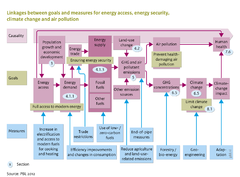Air pollution and energy policies: Difference between revisions
Jump to navigation
Jump to search
No edit summary |
Oostenrijr (talk | contribs) No edit summary |
||
| (5 intermediate revisions by 3 users not shown) | |||
| Line 2: | Line 2: | ||
|Application=Roads from Rio+20 (2012) project; | |Application=Roads from Rio+20 (2012) project; | ||
|KeyReference=Kruyt et al., 2009; Van Ruijven et al., 2012; | |KeyReference=Kruyt et al., 2009; Van Ruijven et al., 2012; | ||
|Reference=EC, 2010; AGECC, 2010; | |Reference=EC, 2010; AGECC, 2010; Jewell et al., 2016; | ||
|Description=Many countries have formulated explicit policies to address the role of the energy system in achieving their development ambitions. These policies are clustered under goals for affordable energy, clean energy, and reliable energy. The EU Energy Strategy, for instance, aims for a competitive, sustainable and secure energy system ([[EC, 2010]]). Similarly, the UN Secretary-General Advisory Group on Energy and Climate Change ({{abbrTemplate|AGECC}}) states as goal ensuring reliable, affordable, and sustainable access to modern energy services ([[AGECC, 2010]]). | |Description=Many countries have formulated explicit policies to address the role of the energy system in achieving their development ambitions. These policies are clustered under goals for affordable energy, clean energy, and reliable energy. The EU Energy Strategy, for instance, aims for a competitive, sustainable and secure energy system ([[EC, 2010]]). Similarly, the UN Secretary-General Advisory Group on Energy and Climate Change ({{abbrTemplate|AGECC}}) states as goal ensuring reliable, affordable, and sustainable access to modern energy services ([[AGECC, 2010]]). | ||
| Line 9: | Line 9: | ||
The three energy goals represent trade-offs, but also opportunities for synergy, and model studies can help to identify and explore these. An important interaction is also with the climate policies discussed in Component [[Climate policy]]. | The three energy goals represent trade-offs, but also opportunities for synergy, and model studies can help to identify and explore these. An important interaction is also with the climate policies discussed in Component [[Climate policy]]. | ||
Here, we focus on access to modern energy sources (affordable), and air pollution reduction (clean) and energy security (reliable). Energy security concerns may limit use of foreign supplies, with possible implications for domestic energy prices and environmental impacts. Access to modern energy generates additional demands for fuel and electricity with benefits for economic development, but may also lead to more energy imports. Outside air pollution from burning fossil fuels may increase, but phasing out traditional bioenergy will substantially reduce indoor air pollution, resulting in net health improvements. Currently, in some regions and cities burning fossil fuels and biomass contributes to severe and increasing levels of air pollution and associated health impacts, see also Component [[ | Here, we focus on access to modern energy sources (affordable), and air pollution reduction (clean) and energy security (reliable). Energy security concerns may limit use of foreign supplies, with possible implications for domestic energy prices and environmental impacts. Access to modern energy generates additional demands for fuel and electricity with benefits for economic development, but may also lead to more energy imports. Outside air pollution from burning fossil fuels may increase, but phasing out traditional bioenergy will substantially reduce indoor air pollution, resulting in net health improvements. Currently, in some regions and cities burning fossil fuels and biomass contributes to severe and increasing levels of air pollution and associated health impacts, see also Component [[Land and biodiversity policies]]. | ||
|IMAGEComponent=Land and biodiversity policies; Climate policy; | |IMAGEComponent=Land and biodiversity policies; Climate policy; | ||
|ComponentCode=APEP | |ComponentCode=APEP | ||
| Line 20: | Line 15: | ||
|AggregatedComponent=Policy responses | |AggregatedComponent=Policy responses | ||
}} | }} | ||
{{#default_form:PolicyResponseComponentForm}} | |||
Revision as of 10:43, 6 June 2017
Parts of Air pollution and energy policies
| Component is implemented in: |
| Related IMAGE components |
| Projects/Applications |
| Key publications |
| References |
Key policy issues
- How do energy policies contribute to economic and social development, and how do they support or hamper a more sustainable future?
- How can the goals for affordable, clean and reliable energy be achieved taking into account possible synergies and trade-offs?
Introduction
